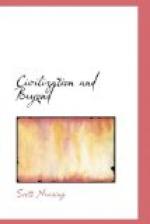Extensive in time and massive in the volume of their architecture are the remains of Egyptian civilization. The earliest of these fragments date back for more than six thousand years.
The seat of Egyptian civilization was the Nile Valley and its estuary built out into the Mediterranean Sea from the debris of disintegrating African mountains. Annual floods left their silt deposits to deepen the soil along the lower reaches of the river. River water, impounded for the purpose, provided the means of irrigating an all but rainless desert countryside. Skillful engineering drained the swamps, adding to the cultivable area of a narrow valley cut by the river through jagged barren hills. Deserts on both sides of the Nile protected the valley against aggressors and migrants. Within this sanctuary the Egyptians built a civilization that lasted, with a minor break, for some 3,000 years.
Egyptian temples and tombs carry records chiseled and painted on hard stone, which throw light on the life and times of upper-class Egyptians, including emperors, provincial governors, courtiers, generals, merchants, provincial organizers. In a humid, temperate climate these stone-cut and painted records would have been eroded, overgrown and obliterated long ago. In the dry desert air of North Africa they have preserved their identity through the centuries.
Since the Egyptians had a few draft animals, and little if any power-driven machinery, energy needed to build massive stone temples, tombs and other public structures must have been supplied by the forced labor of Egyptians, their serfs and slaves.
Egypt’s history dawns on a well-organized society: The Old Kingdom, based on the productivity of the narrow, lush Nile Valley. The products of the Valley were sufficient to maintain a large population of cultivators: some slave, some forced labor, about which we have little knowledge; a bureaucracy, headed by a supreme ruler whose declared divinity was one of the chief stabilizing forces of the society. Between its agricultural base and its ruling monarch, the Old Kingdom had a substantial middle class which procured the wood, stone, metals and other materials needed in construction; a corps of engineers, technicians and skilled workers, and a substantial mass of humanity which provided the energy needed to erect the temples, monuments and other remains which testify to the political, economic, and cultural competence of the ruling elements and the technical skills present in the Old Kingdom.
Foremost among the factors responsible for the success of the Old Kingdom was the close partnership between the “lords temporal” and the “lords spiritual”—the state and the church. The state consisted of a highly centralized monarchy ruled by a Pharoah who personified temporal authority. This authority was strengthened because it represented a consensus of the many gods recognized and worshiped by the Egyptians of the Old Kingdom. The monarch was also looked upon as an embodiment of divinity. Some Egyptian pharoahs had been priests who became rulers. Others had been rulers who became priests. The two aspects of public life—political and religious—were closely interrelated.




